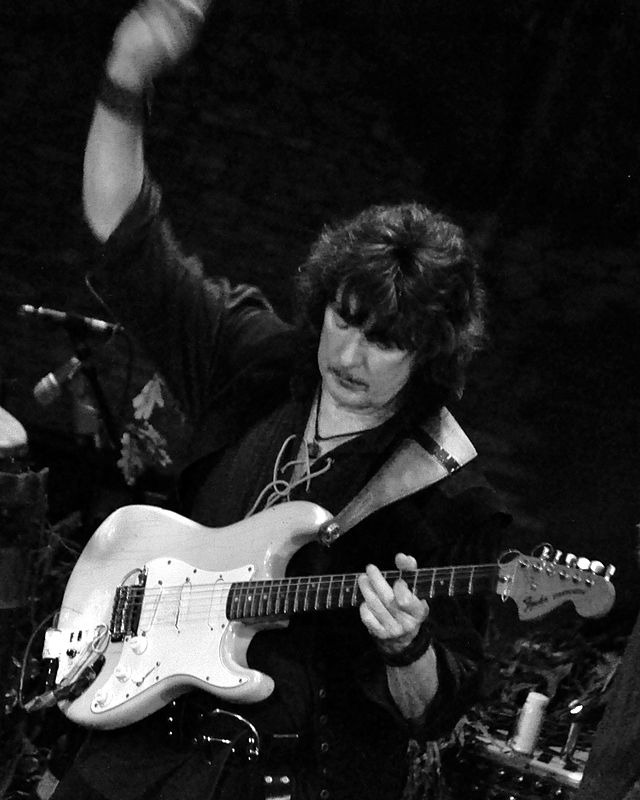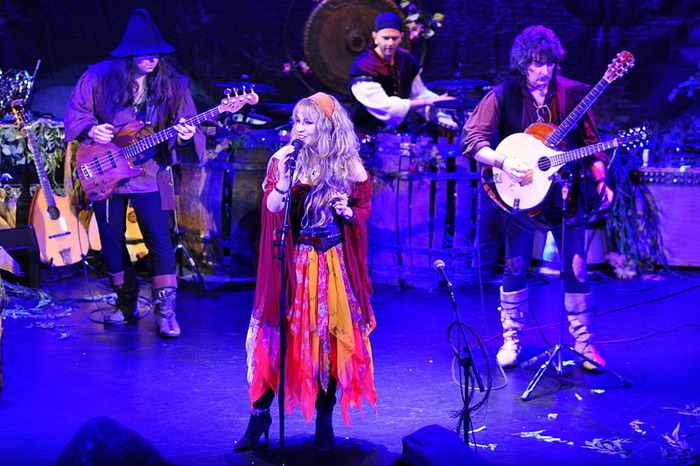

 By VennerRoad, 13th Apr 2015
By VennerRoad, 13th Apr 2015

Ritchie Blackmore in 2012.
An overview of the music of legendary guitarist Ritchie Blackmore from 1968 to the present day.
The music of the legendary rock guitarist can be divided, broadly speaking, into five eras:
Pre-Deep Purple
Deep Purple
Rainbow
Deep Purple reunited
Blackmore’s Night.
Richard Hugh Blackmore was born at Weston-super-Mare on April 14, 1945; the family moved to Heston, West London (near when I grew up) when he was two years old. He was given his first guitar as a boy by his father, and after studying the classical instrument, graduated to the electric one. Ritchie left school at 15, took electric guitar lessons and found regular work as a session man. He played in groups too, most famously with The Outlaws (not to be confused with any American band of the same name), and Screaming Lord Sutch. Today, David Sutch – who committed suicide in 1999 – is best remembered as a fringe politician.
Blackmore’s career really took off when along with keyboard wizard Jon Lord, drummer Ian Paice, bass player Nic Simper and lead vocalist Rod Evans he became a founder member of Deep Purple. Although Deep Purple Mark II is generally considered the classic line up, this long time fan would beg to differ. The first three albums were Shades Of...alternatively Shades Of Deep Purple; The Book Of Taliesyn, and The Third Album, which everyone else in the world calls Deep Purple.
All three included covers, although The Third Album – with that marvellous Hieronymous Bosch gatefold sleeve – was limited to Donovan’s Lalena. The first track on Shades Of... announced the band’s presence to the world; And The Address, a fiery instrumental, was also the opening track of their first ever live gig, in Denmark. A Blackmore/Lord composition, it heralded what was to come, but the band changed direction when Evans and Simper departed to be replaced by Ian Gillan and Roger Glover respectively.
Although Deep Purple Mark II was a strong line up, producing the In Rock album, the live double Made In Japan, and what has been called the most famous riff in rock, one can only wonder how Deep Purple would have progressed with the original line up. Or perhaps we don’t have to wonder too much, because Blackmore’s Night is the natural progression from it.
As we will see later with this band, Blackmore has borrowed and adapted classical melodies widely; with Mark I though there was one time he “borrowed”a bit too freely, as Bill Parkinson explained in 2008! More recently he appears to have done the same thing with Carry On...Jon, a track that sounds remarkably like something Gary Moore wrote a quarter of a century earlier.
Deep Purple Mark III resulted from the departures of Messrs Gillan and Glover; the new bass player was Glenn Hughes, and the new lead vocalist, David Coverdale. Although not as strong as either Mark I or Mark II, the two studio albums resulted in four classic numbers: both title tracks, Burn and Stormbringer; Mistreated and Soldier Of Fortune. The latter three are credited solely to Blackmore and Coverdale.
This could have heralded the beginning of a new songwriting partnership along the same lines as Blackmore/Lord, but the next album saw Blackmore replaced by Tommy Bolin, who died tragically young from a drug overdose.
Blackmore had intended to make a solo album, but instead put together a new band. If one were to credit certain elements of the music press, this would have been a power trio with the egocentric axeman emulating Robin Trower. In fact although Ritchie was known to be both temperamental and supremely confident, he was never a big head.
In spite of frequent changes of line-up, the band had a surprisingly democratic structure. He brought in a keyboard player and later a vocalist on rhythm guitar, Joe Lynn Turner.
Rainbow actually had quite a long existence, from 1975 to 1984 and then 1993 to 1997, its original vocalist being the late great Ronnie James Dio, who also fronted Black Sabbath briefly. From the off, the band was unashamedly commercial, recording the Russ Ballard song Since You Been Gone, which was a top ten hit in the UK; All Night Long, and I Surrender which made the top 5, and the number one song in America, Stone Cold with a number 2 the following year, Street Of Dreams.
During this time, Ritchie wrote two classic instrumentals which were released as B sides: Weiss Heim was the obverse of All Night Long in 1980, and Maybe Next Time for I Surrender in 1981.
By the mid-80s, he could have rested on his laurels, but not only did he rejoin a reinvigorated Deep Purple Mark II, the best of him was to come. In 1989, he met a young fan in New York; two years later, they were lovers, more than that, Ritchie had found his soulmate. Candice Isralow was born May 8, 1971 – do the math.
By 1983, the man in black had already been married and divorced three times, and had a son, Jürgen, by his first wife Margit Volkmar. This is par for the course for many people in show business, including music, due to the peripatetic lifestyle; the other big problem is of course substance abuse, especially for musicians. Okay, he was already one of the greatest rock guitarists of all time, and had a few dollars in the bank too, but surely the age gap was just too much. How wrong can anyone ever be? Charles and Diana was a match made in Heaven, on paper, and yet this gorgeous creature was not enough for him. Candice was surely enough for any man, but how long would he be enough for her? Again, how wrong can anyone be? While any bookmaker would have given long odds on their relationship lasting more than a year or two, Candice will be 44 this year, and is now a mother of two. Not only that, as stunning as she was when they first met, she has grown more beautiful with age, a rare quality in a woman.
Ritchie married his Fairie Queen only in 2008 – after a fourteen year engagement! – but she began working with him way before that. Apart from stunning good looks, what does the fourth (and final) Mrs Blackmore bring to the table? Candice Night is a classically trained pianist, although she doesn’t play keyboards on stage; she has a deep knowledge of and appreciation for contemporary – and thanks to her husband not so contemporary music – she sings like an angel, plays several Mediaeval musical instruments, and is a lyricist par excellence as well as occasionally writing complete songs. And she has so much personality, it really is like she fell from Heaven.
Lucky man that Ritchie is, music is the big winner here. Since 1997, Blackmore’s Night have produced nine studio albums, which is not a prodigious output when one considers the staggering quantity recorded by bands and singer-songwriters in especially the 1970s due to contractual obligations, but there have been live albums too, touring of course, and even a genius is entitled to a family life.
While the quantity put out by Blackmore’s Night has been quite impressive, the quality is something entirely different, and it is really no exaggeration to say that it excels his efforts with both Deep Purple and Rainbow. The combination of ye olde and the new has made him inarguably the most important and influential figure in this emerging genre. It should be mentioned that Ritchie is a composer rather than a lyricist; the only song to which he has ever made a lyrical contribution is Under A Violet Moon, which he wrote with Candice.
Blackmore’s Night live shows are spectacular events with band members dressing in Mediaeval style; they also have a leaning towards the acoustic, and he has never been afraid to allow other instrumentalists to stamp their marks on their performances, including a violinist, and Candice usually on shawm. Although their concerts now attract huge crowds, they remain intimate affairs; in the studio though, his rock roots shine through.

Ritchie on stage with Candice in 2012.
A few words about technical matters; in a 1991 interview with Guitar World magazine, Ritchie said he began using vibrato extensively on In Rock after seeing The James Cotton Blues Band; the guitarist concerned appears to have been Luther Tucker. He says he went mad with it for awhile.
In addition to mixing the Blues scale with the Dorian and chromatic scales, he is said to have been the first rock guitarist to make extensive use of the Aeolian Minor, and to occasionally throw in a few notes from his own Blackmore’s Snake-Charmer Scale – a variation of the Hungarian Minor. (If that is all Greek rather than Hungarian to you, I haven’t picked up a guitar since the last Millennium).
He is also a master of feedback, and you can find examples of this on YouTube. His trademark guitar is the Fender Stratocaster but early on in his career he used a Gibson. With Blackmore’s Night he has also played the domra, mandolin and hurdy-gurdy. In the studio it is possible to make alll manner of wondrous noises using overdubbing and such, but Blackmore’s Night concerts are not short of those with a full band.
Where does he stand overall? Back in the early 1970s I was told by a fellow chess player – whose name I still remember – that he was the best guitarist in the world. Another, older chess player and music fan ridiculed this claim, but the facts speak for themselves. Ritchie Blackmore has been rated consistently among the all-time greats since the 70s. He was rated number 17 in 2012 by Cleveland radio station 98.5 WNCX; Cleveland is a city that knows a thing or two about music. More recently he was rated 55 by Rolling Stone magazine; he has been higher, but on influence alone he is up there with the best of them and will surely remain so.
I’ve seen him perform twice, the first time in Leeds in the 1980s when he was touring with Rainbow, and a decade later at Hammersmith with Deep Purple.
This is not a Blackmore biography. but one thing that should be noted about Ritchie is his humanitarian work, which is not down entirely to the kind-hearted Candice. In December 1988, a powerful earthquake hit Armenia causing massive loss of life and widespread destruction. The following December, Smoke On The Water was re-recorded for Rock-Aid Armenia. For the twentieth anniversary of that project he received the Honorary Medal of the Prime Minister of Armenia.
For the sake of balance I should add that not everyone who has worked with Ritchie Blackmore speaks highly of him personally; let’s just say he could be difficult, and let it go at that. It may be simply that he is not a people person, whatever, he has certainly mellowed with age.
The following purely subjective list – in chronological order – are my top twelve Ritchie Blackmore tracks with some commentary. Apart from that there remains only to be said, thank you for the music. And happy birthday!
And The Address – The first and classic Deep Purple track; this has always been one of my personal favourites.
Why Didn’t Rosemary? – A fun track from The Third Album; this was a group composition, and features Ritchie using wah wah.
April – Another Lord/Blackmore composition; like Ritchie, Jon Lord was not a lyricist, but he did write a few words for this extremely beautiful, 12 minute plus piece which he also orchestrated, again from The Third Album.
This has been one of my favourite instrumentals since before most of you were born.
Child In Time – Likewise one of my favourites, and a favourite of Candice too, even though it was written before she was born! Like all tracks from In Rock, it is a group composition. I have to say I prefer the original studio version to the live Blackmore’s Night version.
Burn – Based on or inspired by Fascinating Rhythm, this uptempo number promised much for Deep Purple Mark III, but was as good as it got. Nevertheless, it is a great way to start an album. I have seen this credited to both the group (sans Hughes) and to Blackmore/Coverdale. We can certainly credit Ritchie with the riff!
Weiss Heim – Ritchie has written quite a few instrumentals over the years, and this is as good as they come.
Maybe Next Time – In the same vein as Weiss Heim, this is nearly as good or slightly better, depending on your point of view.
Son Of Alerik – This was recorded for Perfect Strangers, although it didn’t make it onto the album. A Blackmore solo composition, it is said to have evolved from a jam, and a magnificent piece it is, the sort of track Mark I would have recorded had it stayed together.
Love Conquers All – A rare power ballad that deserved a much better fate in the singles charts. It was co-written with Joe Lynn Turner and Roger Glover for the 1990 Slaves And Masters album.
I Guess It Doesn’t Matter Anymore – Again, this is in the spirit of Deep Purple Mark I; co-written with Candice for the 2006 ...Village Lanterne album, it is original music based on a true story.Well, as true as any ghost story.
Just Call My Name (I’ll Be There) – Also from The Village Lanterne and co-written with Candice, I keep calling her name but she doesn’t answer me! Seriously, it’s clear what inspired this.
Locked Within The Crystal Ball – Recorded for the 2008 Secret Voyage album wherein it runs to a full eight minutes, this is as Mark I as they come, and a truly incredible track; based on the Fourteenth Century chant Stellar Splendens, it features both some dazzling axework and Candice on shawm as well as her amazing vocals. It is also a show opener wherein it is given some fine acoustic treatment, but the album version is something else.
To Wikinut Articles Page